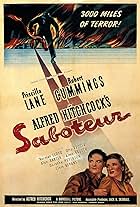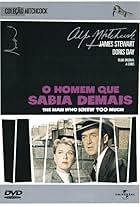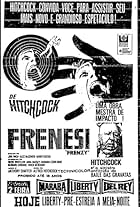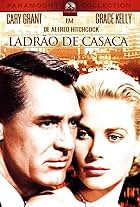Numa pequena cidade da Nova Inglaterra, um corpo é encontrado na floresta, criando uma confusão: todos querem esconder o corpo ou livrar-se de suspeitas por todos pensarem que o morto é resp... Ler tudoNuma pequena cidade da Nova Inglaterra, um corpo é encontrado na floresta, criando uma confusão: todos querem esconder o corpo ou livrar-se de suspeitas por todos pensarem que o morto é responsabilidade sua. Mas afinal, quem o matou?Numa pequena cidade da Nova Inglaterra, um corpo é encontrado na floresta, criando uma confusão: todos querem esconder o corpo ou livrar-se de suspeitas por todos pensarem que o morto é responsabilidade sua. Mas afinal, quem o matou?
- Direção
- Roteiristas
- Artistas
- Indicado para 2 prêmios BAFTA
- 1 vitória e 4 indicações no total
- Ellis
- (não creditado)
- Man Walking Past Sam's Outdoor Exhibition
- (não creditado)
- Harry Worp
- (não creditado)
- Art Critic from the Modern Museum
- (não creditado)
- Direção
- Roteiristas
- Elenco e equipe completos
- Produção, bilheteria e muito mais no IMDbPro
Avaliações em destaque
Part of the joke that's "The Trouble With Harry" is that "nothing happens." Hitchcock's "anti-Hitchcock" film defies expectations for action, shock, mayhem, suspense, spectacular climaxes on national monuments, etc. Instead, it's a New England cross-stitch of lovingly detailed writing, acting, photography, directing and editing.
Saul Steinberg's title illustration tells you exactly what you're in for. One long pan of a child's drawing of birds and trees . . . ending with a corpse stretched out on the ground as "Directed by Alfred Hitchcock" briefly appears.
So meticulously is "The Trouble With Harry" conceived, the only two images in the title art that are NOT trees, plants or birds are a house with a rocking chair on its porch and that corpse. The film literally plays in reverse of the title sequence -- from little Arnie's (Jerry Mathers, pre-Beaver. The boy who drew the titles?) discovery of the corpse, back to the home with the rocking chair, as Hitchcock's final "joke" puts the audience safely to bed. A double bed, in this case.
What's the film about? Oh, Great Big Themes like Life and Death, Youth and Age, Love and Hate, Guilt and Innocence, Truth and Lies, Art and Pragmatism -- packaged with deceptive simplicity.
The "hero," Sam Marlowe (John Forsythe), is an artist. The man the "child" who drew the titles (Arnie, or someone like him) might have become. His name is an amalgamation of two of hard-boiled fiction's greatest detectives: Sam Spade and Philip Marlowe. Indeed, Sam Marlowe functions here as a "sort of" detective. But enough of pointing out the detailed construction of this script and film: repeated viewings yield far greater pleasures.
"Introducing Shirley MacLaine" in her first screen role threw that enduring actress into an astounding mix of old pros: Edmund Gwenn, Mildred Dunnock, Mildred Natwick and Forsythe. That MacLaine held the screen then, and still does 50 years later (name another major actor who can say that), validates Hitchcock's astute casting.
In fact, TTWH is a tribute to cinematic "acting" as much as anything else. These are among the finest performances ever captured of these terrific actors. Since there are none of the expected "spectacular" Hitchcock sequences, nor his nail-biting tension, all that's left is for the actors to fully inhabit their characters.
That they do with brilliance, efficiency and breathtaking comic timing. No pratfalls here. Just nuances.
Edmund Gwenn and Mildred Natwick are the real stars. Had Hitchcock said so, the film would never have been produced. Their scenes (they receive as much if not more screen time together than Forsythe and MacLaine) are possibly the most delightful (and yes, romantically and sexually tense) ever filmed of courtship in middle-and-old age. Perfectly realized in every intonation and gesture. Occasionally laugh-out-loud funny.
Theirs is paralleled by the courtship of the younger "stars," Forsythe and MacLaine. "Love" at both ends of life, young and old, and love's wonderful humor and mysterious redemption, even in the face of death -- that inconvenient corpse on the hill.
Perhaps the most surprising and powerful undertow in "The Trouble With Harry" (one hesitates to name it because it's handled so delicately) is Sex.
It is only barely present in the lines given the characters, but the subtext is always there. Occasionally, it boils over into an infinitely subtle burlesque, as in the exchange between Gwenn and Forsythe about crossing Miss Gravely's (get that name?) "threshold" for the first time.
The look in Gwenn's eyes and the repressed joy and romantic hope in his face -- even at his stage of life -- is bliss.
The coffee cup and saucer "for a man's fingers;" the ribbon for Miss Gravely's newly-cut hair (Wiggy cuts it in the general store -- Mildred Dunnock in another unbelievably subtle performance -- muttering, "Well, I guess it will grow back."); Arnie's dead rabbit and live frog; the constantly shifting implications of guilt in the death of "Harry" up there on the hill; the characters' struggles to regain innocence by "doing the right thing"; the closet door that swings open for no apparent reason (never explained); the characters' revelations of the truths about themselves; their wishes granted through Sam's "negotiations" with the millionaire art collector from the "city" -- ALL portrayed within the conservative but ultimately flexible confines of their New England repression and stoicism (yes, the film is also a satiric comment on '50s morality) -- these details and more finally yield a rich tapestry of our common humanity, observed at a particular time and place, through specific people caught in an absurd yet utterly plausible circumstance.
Nothing happens? Only somebody who doesn't know how to look and listen -- REALLY observe, like an artist / creator -- could reach that conclusion about "The Trouble With Harry." Only a genius, like Hitchcock, would have the audacity to pull the rug out from under his audience's expectations at the height of his career by offering a profoundly subtle morality play in the guise of a slightly macabre Hallmark Card.
When the final "revelation" arrives, in the last line that takes us home to the marital bed where love culminates and all human life begins -- yours and mine -- and draws from us a happy smile of recognition, so Hitchcock's greatest secret is revealed, more blatantly in this than any of his films.
"Life and death -- and all of it in between -- are a joke! Don't you get it?" It's there in all his pictures. Nowhere more lovingly and less showily presented than in "The Trouble With Harry." Thank you, Hitch.
The Trouble with Harry has the unique distinction of being only one of two comedies that Hitch made, in the U.S. anyway. The other being Mr. & Mrs. Smith. Of course Hitch is famous for little touches of black humor, but on this film he went all out. A plain, simple, black comedy that probably ends up flying under the radar of people used to watching Marx Bros. films, who I also like.
While not exactly, laugh-out-loud comedy I enjoy watching it. I think it's a relaxing film, especially when you see the great photography that captures the beauty of autumn in New England. Then again, I don't think you can ever get a bad shot of that. It's an amusing tale with good acting from John Forsythe, Shirley MacLaine, Edmund Gwenn, and Mildred Natwick occupying the main and almost only roles in the film. It also marks the first collaboration between Hitchcock and Herrmann who brings a light, airy, and playful score that helps make the concern of the story less of 'how' Harry died, but what exactly to do with him.
Basically, if you like Hitchcock, black comedy and don't mind an uncomplicated story, then I highly recommend it.
Within the opening five minutes, my jaw dropped at the sheer ludicrousy of the movie's premise the offbeat reactions of all the characters to the troubled Harry and how I laughed at the audacity the film had to throw so many off the wall characters into a situation that grew more and more outrageous with every passing frame and keep running with a straight face.
We get a retired ship captain, an old woman looking for love, a troubled widow, an artist with a taste for the weird, a dead guy, and it only gets more and more strange, folks. The plot? It goes in circles over and over and over again, and not much really happens as this group tries to figure out Harry and what to do with him. Needless to say, The Trouble with Harry walks dangerously close to disaster, but Hitchcock does something remarkable: he lets his style seduce the audience into suspending their disbelief, sitting back, and trusting the master of black comedy.
That is what I love about Hitchcock and about Trouble with Harry he is so confident in his films and his audience that he knowingly presents the absurd where other filmmakers wouldn't dare go in fear of losing the audience. He knows precisely which ties to reality he can afford to cut free, and he so gracefully and fearlessly lets go of "realism" in favor of his own flavor of the surreal. The Trouble with Harry presents some of the goofiest characters to ever appear on screen with some of the strangest logic-defying ideas, and I love them for it.
How does it work? The film simply resonates with the charms Hitchcock fans have grown to adore how the grassy hill looked like a set, the witty dialogue between the characters (the captain and Sam cracked me up every time), the mastery of frame composition (loved the first few shots of Harry), and Bernard Herrmann's delightful score that perfectly reflects the tone and feel of the film. Murder never felt so whacky and wonderful. It's that same world of Hitchcock that made us, the audience, forget about logic and realism when we viewed North by Northwest, Psycho, and Rear Window.
Realism is boring. As Sir Alfred, himself, stated, "Most films are slices of life. Mine are slices of cake." And indeed, his world is so much more fun. Screw reality.
This movie is a gem that's easily overlooked since it is a comedy by the "master of suspense." Fans already know he had also mastered the art of black comedy, and the only phrase I need in describing the film to fellow Hitch fans is "pure cinema." The Trouble with Harry is Hitchcock at his best, and it's no trouble at all to sit through.
This film does a good job at showing what life is like (in a twisted way) in a small American town. Of course the whole thing is a black comedy about a corpse, but it's great fun, and suspenseful too, especially when Calvin is in the room, questioning everybody. I didn't understand why the door kept opening, but maybe it was just a joke - normally the door would signal a killer entering or something like that - but the door is never any cause for alarm.
All the actors are good, especially Gwenn, and Mrs. Gravely was so endearing. Don't ignore this lesser known Hitchcock movie. It's a treat to watch and is genuinely funny.
Você sabia?
- CuriosidadesThis movie was Sir Alfred Hitchcock's experiment to see how audiences would react to a non-star-driven movie. He was of the opinion that oftentimes having a big star attached hindered the narrative flow and style of the story. He also developed the movie to test how American audiences would react to a more subtle brand of black humor than they were used to.
- Erros de gravaçãoWhen Miss Graveley visits the Captain, we see a case of nautical flags on the wall behind him, with a model ship perched on top. But in the final shot of the scene as Miss Gravely is leaving, the ship is gone.
- Citações
Miss Graveley: How old do you think I am young man?
Sam Marlowe: Hmm... fifty. How old do you think you are?
Miss Graveley: Forty-two! I can show you my birth certificate.
Sam Marlowe: I'm afraid you're going to have to show more than your birth certificate to convince a man of that.
- Cenas durante ou pós-créditosClosing credits: "The trouble with Harry is over."
- Versões alternativasIn a version seen on commercial television in the UK, several scenes and parts of scenes were cut. Most noticeable was the removal of the scene in which Sam, the artist played by John Forsythe, walks through the village in long shot singing "Flaggin' the Train to Tuscaloosa" (still present in the titles). Also, the doctor's brief appearances up to his final discovery of the body were cut, making Sam's prior inclusion of his name in the list of people who could go to the police rather confusing! This also meant the 'famous' shot used on the posters of Sam and the Captain each holding one of Harry's legs was cut.
- ConexõesFeatured in The Trouble with Harry Isn't Over (2001)
- Trilhas sonorasFlaggin' the Train to Tuscaloosa
Lyric by Mack David
Music by Raymond Scott
Sung by Ray McKinley & Orchestra
Principais escolhas
Detalhes
Bilheteria
- Orçamento
- US$ 1.200.000 (estimativa)
- Tempo de duração1 hora 39 minutos
- Cor































